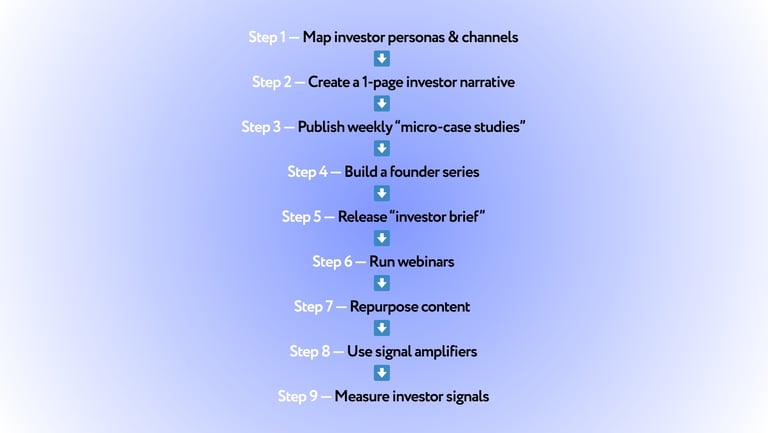How can startups attract investors using content?
A practical, step-by-step playbook for founders — with real stats, examples, and templates you can use today.
11/17/20255 min read


Investors do not buy complexity. They buy clarity, traction, and trustworthy founders. Content is how you demonstrate those three things before your first pitch meeting. Done right, content turns cold outreach into warm introductions, makes do diligence easier and shortens the path to term sheets. Content that educates, proves and builds the founder’s brand moves investors from curiosity to a meeting.
Why create content?
Investors judge perception fast.
Many investors scan a founder’s online presence before a meeting; a clear, active presence reduces friction and increases meeting quality. LinkedIn has become the default professional storefront for founders and investors. (Kinsta®)Content drives measurable demand.
Across B2B, content marketing consistently generates leads and nurtures them into opportunities — HubSpot reports strong lead-generation and nurturing benefits from content. (HubSpot)Content delivers long-term ROI.
Industry data shows content marketing yields reliable ROI compared with interruption-based tactics. For example, Forbes & aggregated studies report strong returns from consistent, strategic content. (Forbes)
The Investor Mindset
When an investor evaluates your startup, their mental checklist often includes:
Technical credibility — does the team understand the science?
Market understanding — do they know the problem and routes to customers?
Traction & momentum — signals that adoption or interest exists.
Founding team quality — are founders communicative, coachable, and credible?
Clarity of vision — can this be explained quickly to non-experts and partners?
Content should be built to answer these five investor questions before the first pitch.
3 Content Pillars for Investors
Structure your content engine around three investor-facing pillars:
1. Proof content
Publish succinct validation stories: pilot results, sample-size outcomes, side-by-side comparisons, clinical readouts, or key internal performance metrics.
Format: short case studies, one-page downloads, charts, and “what we measured” posts.
Why it works: Investors want facts; an easy-to-digest case study reduces due-diligence friction.
Example: “We tested X on 120 clinical samples — sensitivity improved by 28% vs standard.” (Attach a simple visual.)
2. Story content
Use founder threads, short videos, and "why we started" posts to show conviction and domain mastery.
Format: founder LinkedIn threads, 3–5 minute YouTube founder interviews, whiteboard explainers.
Why it works: Investors fund founders as much as ideas. A founder who can explain the strategy and the business logic convincingly increases investor confidence.
3. Educational content
Publish explainers that scaffold the market problem and why your solution is uniquely positioned.
Format: long-form blog posts, mini whitepapers, webinars, and explainer videos.
Why it works: It demonstrates domain expertise, shows customer empathy, and helps investors understand the TAM and adoption pathways.
9 Steps to attract investors
1. Map personas & channels
Identify the types of investors you want (angels, deep-tech VCs, corporate VC). Then map where they spend time: LinkedIn for mid/large VCs, Twitter/X for some founders and investors, and niche newsletters or conferences for sector experts.
Tip: Many VCs and angels post on LinkedIn — optimize your presence there.
Business Insider
2. Create a one-page narrative
Before publishing, write a 1-page summary: problem, solution, validation, go-to-market, ask. This becomes the base for every content piece. Every post should answer one line from that page.
3. Publish weekly case studies
Each week, publish a short post or thread showing one data point or customer insight. Use visuals and a single CTA (“DM for data”, “download full one-pager”).
4. Build a founder series thread
A 3–5 tweet or LinkedIn thread — “How we validated X” or “What we learned from our first pilot” — humanizes the team and invites conversation. Investors read threads; they look for honesty, not hype.
5. Release a quarterly “investor brief”
A short PDF update (2–4 pages) that consolidates milestones, experiments, KPIs, and next steps. Offer it on your site behind an email capture to build a qualified lead list.
6. Run founder-focused webinars
Invite industry experts and present data. Webinars are discovery tools: investors sometimes join as listeners; afterwards, you have a warm list to follow up with. Use these recordings as evergreen content on YouTube.
7. Repurpose content across platforms
Turn one investor brief into: LinkedIn posts, a short YouTube explainer, an X thread, and an email to your supporters list. Repurposing maximizes reach with minimal extra effort.
8. Use signal amplifiers
Tag collaborators, labs, and pilot partners when posting validation. When neutral third parties (labs, CROs, clinics) confirm results, it raises trust enormously.
9. Measure investor signals
Track profile views by investor titles, DM requests from investors, downloads of investor briefs, meetings booked, and investor replies — not only likes or impressions. A 2% increase in investor meetings is far more valuable than 10,000 impressions from irrelevant audiences.
Sample content calendar
Week 1: Founder thread — origin story + one monthly goal.
Week 2: Micro-case study — 1 validation datapoint + visual.
Week 3: Educational post — market problem & your unique approach.
Week 4: Investor brief (PDF) + webinar invite.
This consistency demonstrates momentum and keeps investors watching.
What works for biotech?
Biotech investors are more technical and cautious than many other sectors. That means:
Transparency — but so does compliance. Avoid overclaiming. Use measured language and attach methods.
Data visuals — a clear chart or table helps, especially for clinical or lab results.
Founder credibility — show the team’s scientific pedigree and operational milestones.
Biotech industry guides recommend LinkedIn for corporates and partnerships; life-science content that shares case studies and behind-the-scenes lab work performs well. (Biotechgate)
How to make your content credible?
Source your claims — link to protocols, preprints, or partner validation.
Use visuals — simple charts, before/after tables, schematic diagrams.
Include next-step CTAs — “download brief”, “request data”, “book a demo”.
Preserve regulatory accuracy — avoid definitive clinical claims unless validated.
Repeat your message — consistent themes build recognition.
How to measure the investor signal score?
Create a simple KPI scorecard to track investor-interest signals:
Investor profile views (weekly)
Investor DM / message volume
Investor-type followers (VCs, angels, corp. dev)
Downloads of investor brief
Meetings booked from content
Score them monthly and iterate content based on what moves the needle.
Common Mistakes
Mistake: Posting only press releases or dense papers.
Fix: Turn one paper into 3–4 simple content pieces (visual summary, thread, short video).Mistake: Hiding behind technical jargon.
Fix: Use the “60-second explanation” rule: can you explain your value in one minute to a non-expert?Mistake: No call-to-action for investors.
Fix: Always include one investor-focused CTA — “Download investor brief” or “Book a 10-min data walkthrough”.
How BioVerse helps biotech teams attract investors with content?
At BioVerse, we run a proven Content-to-Capital program for biotech startups:
Investor Persona Mapping
We identify the investor types that best fit your stage & science.1-Pager to Content Pipeline
We convert your investor narrative into weekly micro-content.Proof Packaging
We design case-study templates and data visuals suitable for investor review.Founder Storycrafting
We help founders craft authentic threads, video scripts, and interview outlines.Distribution & Signal Tracking
We post, engage, and report on investor signals — then refine.
We have helped biotech clients increase investor meetings and inbound interest by focusing on clarity, proof and consistent founder visibility.
PSA: Legal & Compliance
Always check regulatory guidance before publishing claims about diagnostics, therapeutics, or clinical results. Use neutral language and link to validation methods or preprints where possible.
Final Thought
In biotech, the path from discovery to impact depends on one silent factor: visibility. Investors invest in potential they can understand and picture. Content — built around proof, story, and education turns obscure breakthroughs into obvious opportunities. Start small, be consistent, and design every piece of content to answer an investor’s question. Do this well and you’ll find that funding conversations start happening earlier and more often.
If you’d like help building a content engine that attracts investors (without the noise), let’s talk. BioVerse builds investor-focused content systems for biotech founders — from founder threads to investor briefs and webinars.
📅 Book a Free Call with our team
🌐 Learn more: www.bioverse.social


